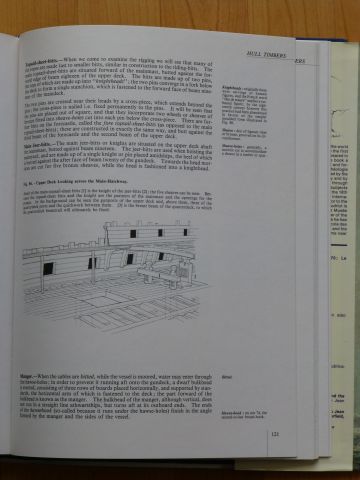01.06.1794 - 220 Jahre Seeschlacht am Glorreichen 1. Juni

Titel: The Seventy-Four Gun Ship, Vol. 1 bis Vol. 4
Autor: Jean Boudriot
Verlag: Jean Boudriot Publications
Erscheinungsjahr: 1986-1988
ISBN: Vol. 1 - 2-903178-14-3
Vol. 2 - 2-903178-15-1
Vol. 3 - 2-903178-16-X
Vol. 4 - 2-903178-17-8
Preis: 416,-€, zusätzlicher Plansatz im Maßstab 1/72 - 42.-€
Das Rückgrat der französische Schlachtflotte in der Schlacht am Glorreichen Ersten Juni heute vor 220 Jahren (siehe Jahrestage auf Modellmarine) bildeten 74-Kanonenschiffe.
Inhaltsverzeichnis
Volume 1 - Hull Construction
- Administration of the Ports and Dockyards
- General Organisation
- Surveyors
- Summary Table
- The work of the Surveyors
- Qualities Demanded of a Warship
- Study of Hull Shapes
- Ships Draughts
- Calculations
- Specifications
- The Work of the Shipwrights
- Moulding in the Loft
- Marking out and Fashioning in the Yard
- Dockard and Installations
- Slipway and Keel Blocks
- Raising and Horning of the Timbers
- Launching
- Hull Timbers
- Keel and Stern Timbers
- The Station-Frames
- Stern-Frame
- Filling Timbers
- Reinforcement and Planking of the Hold
- Construction of the Decks
- Internal Planking above the Hold
- Description of other Inboard Works
- External planking of the Hull
- Fastening - Caulking
- Nails - Fastenings
- Nailing - Fixing of the Bolzts
- Oakum - Pitch
- Tables, etc.
- Table of Dimensions
- Table of Scantlings
- Sequence of Construction
- Vocabulary
Volume 2 - Fitting Out the Hull
- Hull Fittings
- The Bow
- The Ship's Sides
- The Stern
- Internal Arrangements
- The Hold and Orlop
- The Gundeck
- The Upper Deck
- The Forecastle, Quarterdeck and Poop
- The Officers' Quarters
- Paintwork
- Ballast and Stowage
- Ballast
- Stowage
- Victuals
- Warrent-Officers' Stores
- The Bo'sun
- The Cook and the Baker
- The Master
- The Carpenter
- The Caulker
- The Gunner
- The Master-at-Arms and the Armourer
- The Sip's Boats
- The Chaplain
- The Surgeon
- The Midshipmen
- Sundry Items of Stores

Volume 3 - Masts - Sails - Rigging
- Masting
- General Considerations
- Types of Timber and Mast-Making
- Standing Masts
- Other spars, and spares
- Mast furniture
- Sails
- Sailcloth and Sailmaking
- List of Sails and their Proportions
- Rigging
- Ropemaking and Related Skills
- Blocks and Block-Making
- Standing Rigging
- Running Rigging - Yards
- Running Rigging - Sails
- Anchor Cables and Related Ropes
- Rigging of the Ship's Boats
- Maintenance
Volume 4 - Manning - Shiphandling
- The Crew
- Officers - Volunteers - Midshipmen
- The Men
- The Marines
- Supernumeraris
- Officers and Crew at Work
- Functios - Responsibilities
- Watch-Bill, Quarter-bill, Messing
- Policing - Discipline
- Seameanship
- Fighting Drill
- Life on Board
- Clothing - Berthing - Other Details
- Religious Observance
- Victuals
- Health and Health care
- Shiphandling
- The Ship in the Harbour
- Anchored in the Roards
- Shiphandling at Sea
- Naval Evolutions and Operations
- Single Ship Evolutions
- Fleet Operations
- Navigation _Coloures and Signals
- Navigation Instruments
- Navigation
- Flags, Coloures and Signals
Inhalt
Jean Boudriot beschreibt in den vier Bänden von "The Seventy-Four Gun Ship" die Konstruktion eines französischen 74-Kanonen-Schiffs und das Leben der Offiziere und Mannschaften an Bord.
In Band 1 der Reihe stellt er die Organisation einer französischen Werft vor und beschreibt die Konstruktion des Rumpfes. In Band 2 widmet sich der Autor den zahlreichen Ausrüstungsdetails des Schiffs. Der Takelage ist Band 3 der Reihe gewidmet. In Band 4 schildert der Autor das Leben der Besatzung auf dem Schiff.
Zahlreiche Grafiken und ausklappbare Tafeln ergänzen den Text. Zusätzlich werden die ausklappbaren Tafeln auch als Planmappe im Maßstab 1/72 für Modellbauer angeboten.

Fazit
Das 74-Kanonen-Schiff wird häufig als Rückgrat der englischen und französischen Flotte im ausgehenden 18. und beginnenden 19. Jahrhundert bezeichnet. Jean Boudriot setzt dem französischen 74-Kanonen-Schiff und den Offizieren und Mannschaften in seinem Werk ein würdiges Denkmal. Die vier Bücher gelten heute zu Recht als das Standardwerk über den französischen Schiffsbau dieser Epoche. Viele der in den Büchern beschriebenen Details lassen sich auch auf französische Linienschiffe 1. Ranges und kleinere Einheiten der Epoche übertragen, da die Konstruktionsprinzipien ähnlich waren.
Für den detaillierten Nachbau eines englischen 74 Kanonenschiffs sind die Bücher dagegen nicht geeignet, da sich die Konstruktion englischer und französischer Schiffe deutlich unterschied; es sei denn, man wählt eine französische Prise, wie die HMS Implacable (ex Le Duguay-Trouin), die in die Royal Navy integriert wurde.
 uneingeschränkt empfehlenswert
uneingeschränkt empfehlenswert
Christian
